0 Introduction In recent years, the combination of embedded technology and Internet technology has made embedded technology play an increasingly important role in remote control, intelligent transportation, video conferencing, security and other fields. With the improvement of people's living standards and the accumulation of personal wealth, cars have gradually become a common means of transportation for people to travel, and cases of car theft are also common. Therefore, how to ensure individual or collective cars has become an urgent problem to be solved. This has prompted us to develop a lower-cost and more convenient video surveillance device—vehicle security system to meet the needs of car owners.
1 System hardware design Automobile security and defense system is mainly composed of video acquisition and processing module, 3G wireless network card, embedded Web Server, GSM module and client browser. The embedded Web Server is made up of Samsung's ARM processor S3c2440 and network chip. The camera first transfers the collected image data to the video processor, which compresses and encodes it, and then passes it to the ARM processor. The ARM processor then compares this frame of data with the previous frame of data. If there is no moving object, the frame is discarded to save storage space; if it is not the same, it indicates that there is a moving object. The processor will store this frame of data and start the GSM module to send an alarm message. If the client wants to know the situation in the car in time, it can access the embedded Web server through the browser to view the real-time video.
The system hardware mainly includes Samsung's ARM processor S3c2440, 3G wireless network card, 16 / 32-bit ARM processor implements MMU, AMBA BUS and Harvard cache architecture, with independent 16KB instruction cache and 16K B data cache. The network chip uses the more commonly used Cs8900.
SDRAM uses two HY57 V561620 (32M). NORFLASH selects AM29LV 160DB. NAND FLASH selects 32M K9F 1208 chip. The video processing part adopts the hardware H.264 codec, specifically adopts QL202B of American Q pixel company, which is a low-power real-time single-chip half-duplex H.264 / AVC encoder. The system hardware structure diagram is shown in Figure 1.
Figure 1 Block diagram of system hardware structure
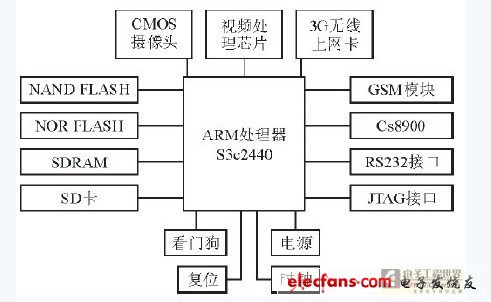
2 Software design The software design of this system includes: transplantation of embedded Linux operating system, writing of video acquisition program and dynamic detection program, realization of embedded Web Server and writing and transplantation of related drivers.
2.1 The dynamic detection of video acquisition The principle of video acquisition and dynamic monitoring is shown in Figure 2. Set the cycle of the camera video collection cycle to T. After the system is initialized, the first frame of the image obtained is saved as a background image. Next, a frame is collected every time T, and the background subtraction method is used to detect the moving target. This detection method is to extract the target from the video stream in real time, detect the points related to the moving three-dimensional object in the image sequence, and filter out the information in the image that is not related to the moving object.
The software is developed using QT / E's image processing class library QImage process. First collect two frames of image data cyclically, and after binarization, extract the brightness of the two images to make a difference. After the background difference image is obtained, it is compared with the set brightness threshold, and if the threshold is not exceeded, the frame is discarded. If this value is exceeded, an alarm is triggered, the GSM module is started to send an alarm message, and at the same time, the ARM processor is notified so that the ARM processor can perform subsequent work.
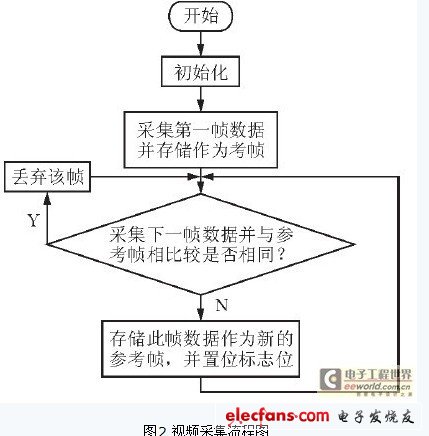
2.2 Software Design of Embedded Web Server The software design of embedded Web Server is divided into two parts:
(1) Configuration and transplantation of Linux server boa;
(2) Implementation of embedded CGI. The working flow chart of embedded Web is shown in Figure 3.
Figure 3 Workflow of embedded Web server
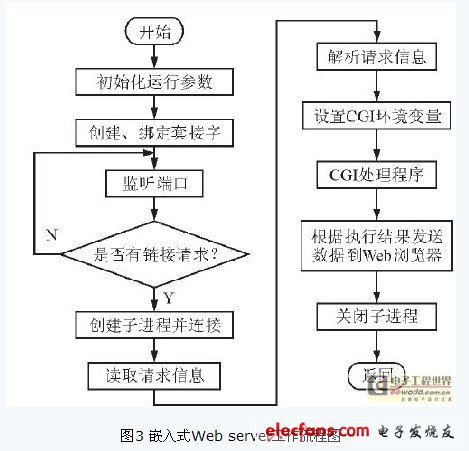
1) Boa transplantation and configuration Boa is a single-task Http server with excellent performance and fast speed. You can download a source version of the boa distribution package on the http: // website to download the source code, and configure and transplant. Since the configuration and transplantation method of Boa can be easily found on the Internet, it will not be repeated here.
2) Embedded CGI
This design requires that the Web can dynamically display and interactively operate. Traditional static web pages do not have such a function. In order to solve this problem, CGI (Common Gateway Interface) can be introduced, which is a standard interface for external application extension applications to interact with the WWW server, which can implement interactive operations between the Web client and the server. CGI can provide many functions that cannot be achieved by static HTML pages, such as search engines, remote monitoring, Web-based database access, and so on. It also has the advantages of fast speed, support for multiple programming languages, and compatibility with browsers. The process of CGI realizing the interaction between client and server is shown in Figure 4.
Figure 4 HTTP call CGI process diagram
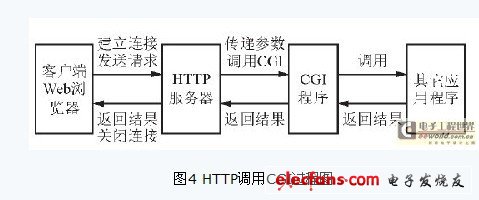
3 Conclusion This system only needs to open any browser and enter the IP number to log in to the embedded server and watch the real-time or historical situation in the car. The video interception picture is shown in Figure 5.
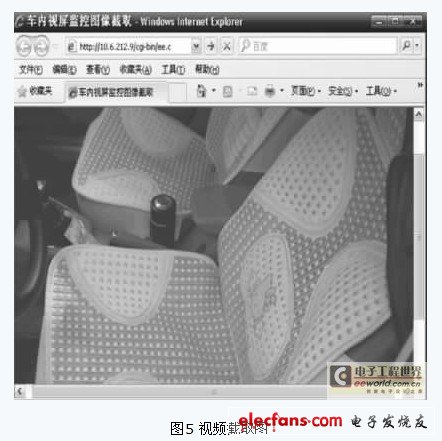
Figure 5 Video interception diagram The vehicle security system solution described in this article has the advantage of being easy to place. Therefore, it has a very broad market prospect in the field of automotive security, but there are areas that need to be improved, such as the limited capacity of the stored video Since each machine has an independent IP, it occupies more IP resources. Furthermore, the amount of video information is very large. The transmission rate of the 3G wireless network card is limited. There will be a delay of several seconds during transmission. I believe that in the near future, with the Compression algorithm technology and the development of 3G wireless Internet card transmission, the popularity of IPV6 protocol and other issues will be solved.
Three-Axis Micro DSLR Stabilizer is composed of pan axis, rolling axis and tilt-axis. With a gyro-stabilized gimbal system, it keeps stabilized or steerable horizon with automatic calibration to give you an unprecedented smooth shooting experience.

Wewow focusing on handheld stabilizer is a technology company which does R & D independently. With Wenpod series product released, the company achieved the industry's praise and quickly became the leader of the smart stabilizer industry.
Our service
1. Reply to you within 24 hours.
2. Already sample: within 1-2days.
3. Shipping date: within 24 hours once get the payment.
4. 12 months warranty.
5. After-sales service, solve within 3 working dates.
Wewow appreciates domestic and international business relationship!
Three-axis Micro DSLR Stabilizer
Three-Axis Micro DSLR Stabilizer,Popular Three-Axis Micro DSLR Stabilizer,Professional Three-Axis Micro DSLR Stabilizer,Handheld Three-Axis Micro DSLR Stabilizer
GUANGZHOU WEWOW ELECTRONIC CO., LTD. , https://www.stabilizers.pl